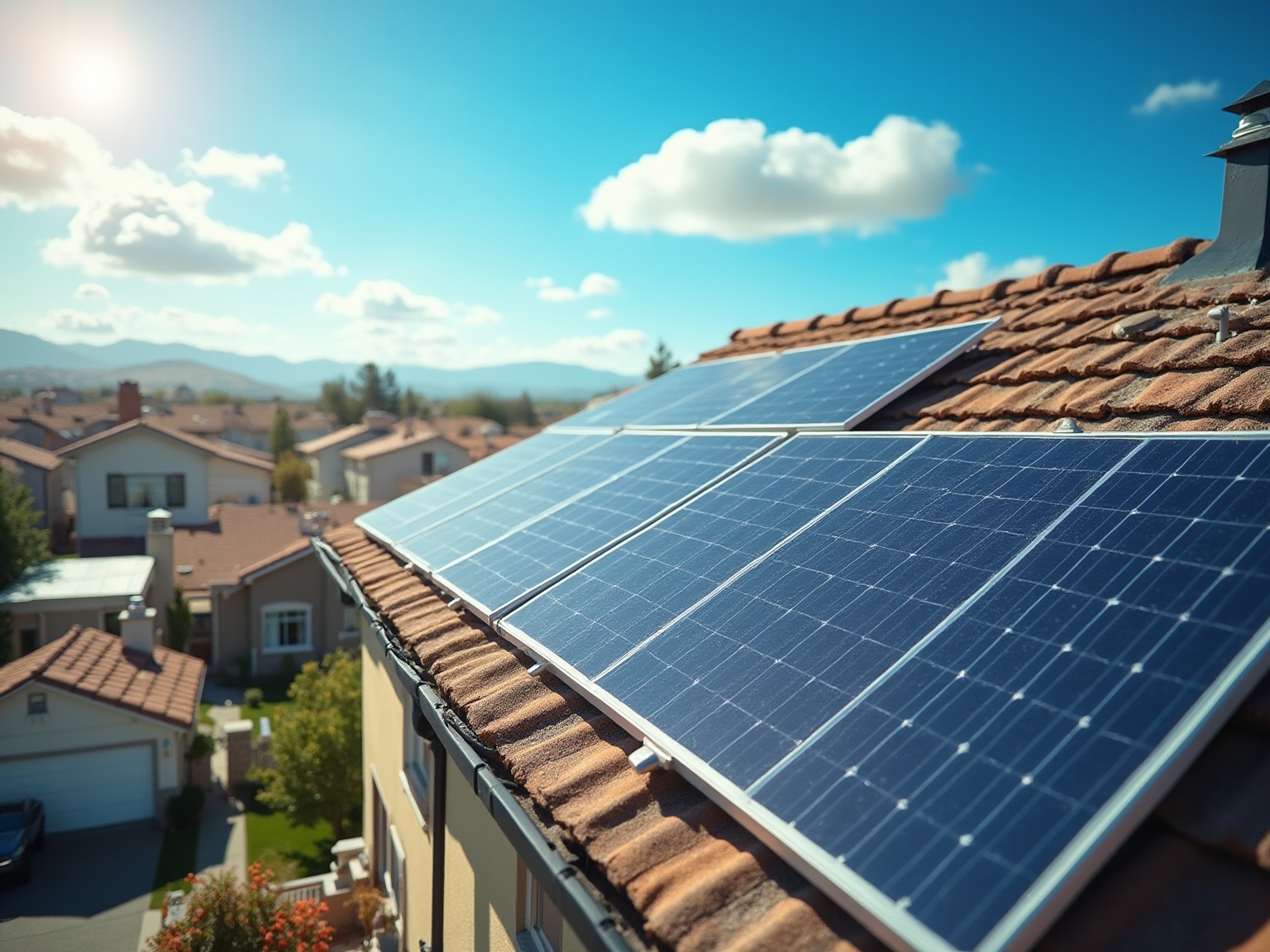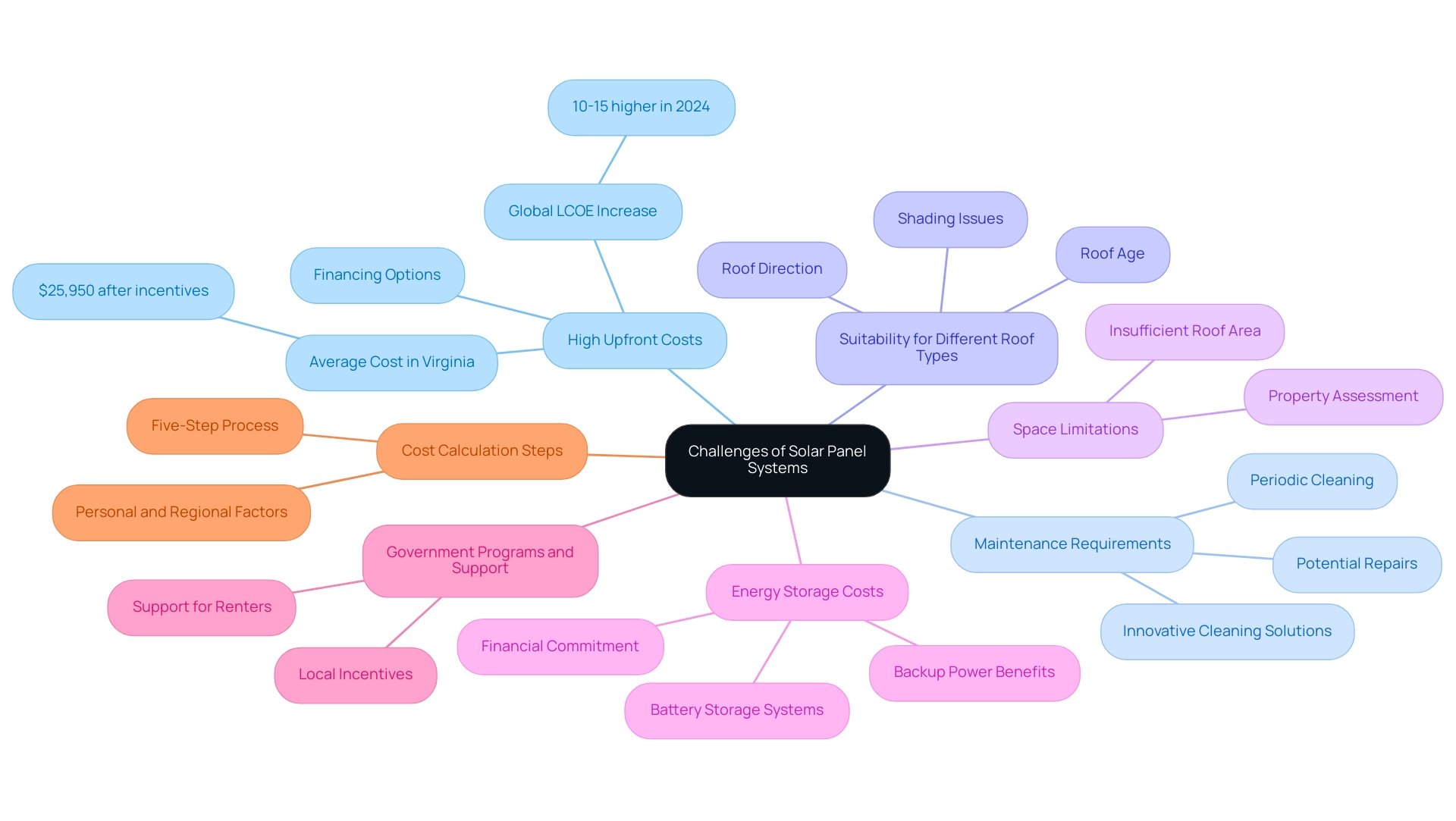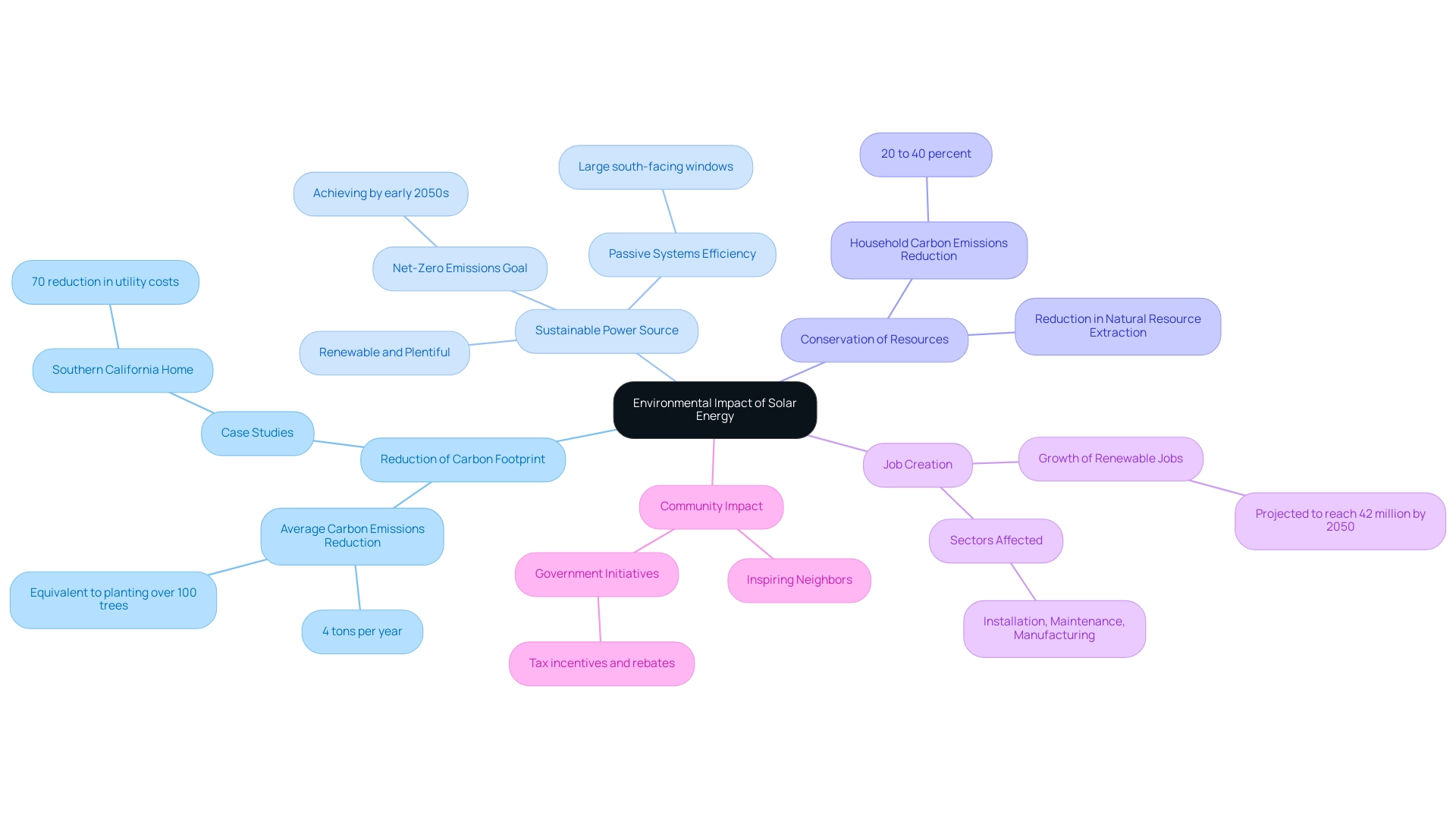Overview
The article explores the pros and cons of having solar panels, highlighting significant benefits such as substantial savings on electricity bills, increased home value, and environmental advantages, while also addressing challenges like high upfront costs and maintenance requirements. It supports these points with examples, including substantial savings reported by homeowners and the potential for increased property value, illustrating how solar energy can be a financially and environmentally beneficial investment despite some initial barriers.
Introduction
With the rising costs of energy and growing concerns about environmental sustainability, many homeowners are considering the switch to solar energy. This decision not only promises significant savings on electricity bills but also enhances property value and contributes to a healthier planet.
As solar technology continues to advance, understanding the benefits, challenges, and financial implications of installing solar panels becomes imperative for those looking to embrace this renewable energy source.
From navigating initial costs and maintenance to exploring government incentives, this guide will illuminate the essential aspects of solar energy, empowering homeowners to make informed choices that align with their financial and environmental goals.
Key Benefits of Installing Solar Panels
- One of the most compelling reasons to consider the pros and cons of having solar panels is the potential for substantial savings on electricity bills. Homeowners, particularly those in sunny states like California, should evaluate the pros and cons of having solar panels to see significant reductions in their monthly utility costs. Recent findings indicate that the average homeowner can save thousands over the lifespan of their energy system, making this a financially savvy choice. For example, a case study from California revealed that a family lowered their electricity bills by 70% after installing a renewable energy system under the 200% Rule, demonstrating the tangible benefits of this investment.
-
Increased Home Value: Numerous studies support the idea that homes equipped with energy systems command higher resale prices. In fact, properties with renewable energy installations can see an increase in value of about 4% to 6%. This is particularly attractive for homeowners considering the pros and cons of having solar panels for future resale opportunities, as it not only enhances their living space but also boosts their investment. The global distribution of photovoltaic infrastructure demonstrates that nations such as China possess over 35% of the global market share, indicating a strong growth trend that can positively impact home values.
-
Environmental Benefits: Embracing photovoltaic energy means opting for a clean and renewable resource that significantly reduces reliance on fossil fuels. By transitioning to renewable energy, property owners can explore the pros and cons of having solar panels, which play a vital part in reducing carbon emissions and creating a healthier planet for future generations. This commitment to sustainability has never been more important, especially as we confront climate change. As noted, ‘A combination of private sector innovation and stable, long-term public policy will set the renewable energy industry on a path to achieving these more aggressive goals to address climate change and decarbonize the economy.’
-
Power Independence: Installing photovoltaic systems enables homeowners to produce their own electricity, which can protect them from increasing utility costs and illustrates the pros and cons of having solar panels, offering a sense of self-sufficiency from service providers. This independence not only provides peace of mind but also helps stabilize costs in an unpredictable market. To further sweeten the deal, many states provide tax credits, rebates, and other financial incentives for those who install photovoltaic panels, which reflects the pros and cons of having solar panels. These programs can greatly reduce the upfront cost, facilitating the shift to renewable power for property owners. With the global renewable energy sector projected to grow at an annual rate of 20%, there’s never been a better time to consider this eco-friendly upgrade.
-
Understanding Residential Renewable Systems Dimensions: It’s crucial for property owners to comprehend the dimensions of residential renewable systems and how they influence power generation and setup. Generally, photovoltaic modules vary from 250 to 400 watts, and the quantity of modules required will rely on the household’s power usage and roof area. By optimizing panel dimensions and quantity, homeowners can enhance their independence and savings.
Ready to make the switch to renewable power? Reach out to Powercore Electric today to discover what renewable power can offer you. Take the first step towards energy independence, financial savings, and a brighter, more sustainable future.
Get Your Free, Personalized Estimate.
Challenges and Disadvantages of Solar Panel Systems
High Upfront Costs
When it comes to investing in solar panels, many homeowners pause at the initial expense. In Virginia, for example, the average expense for a photovoltaic system after incentives is approximately $25,950. While financing options can help ease the burden, these upfront costs often remain a significant barrier for potential renewable energy users.
According to the International Energy Agency, the global average levelized cost of energy (LCOE) for photovoltaic systems is anticipated to be 10–15% higher in 2024 than it was in 2020. This trend highlights the significance for property owners to evaluate the pros and cons of having solar panels, considering the long-term advantages against the initial investment and thinking about acting sooner rather than later. Additionally, the Department of Energy’s SolarApp+ aims to streamline the interconnection process, potentially lowering costs and timelines for installation, which may help alleviate some of the initial financial burdens.
Maintenance Requirements
One of the appealing aspects of solar panels is their relatively low maintenance needs. However, property owners should be aware that periodic cleaning and potential repairs are necessary to keep the system functioning optimally. Staying on top of maintenance not only ensures efficiency but can also prolong the life of your energy investment.
Innovative cleaning solutions are available that can simplify this process, making it easier for homeowners to maintain their systems.
Suitability for Different Roof Types
Not every roof is a perfect candidate for solar panel installation. Elements such as roof direction, age, and shading are crucial in assessing how efficiently photovoltaic systems can produce power. Homeowners should conduct a thorough assessment of their roofs to understand their specific circumstances.
If your roof is suitable for harnessing sunlight, you could be on your way to utilizing the sun’s power!
Space Limitations
Space can also be a limiting factor for solar panel systems. Some homes may not have sufficient roof area to accommodate the panels needed for effective energy generation. If you’re thinking about utilizing renewable energy, take the time to assess your property and its potential while considering the pros and cons of having solar panels.
Understanding these limitations early on can save you from future headaches and help you make informed decisions.
Energy Storage Costs
For those interested in enhancing their solar setup with battery storage systems, it’s important to realize that this comes with its own set of costs. While these systems can offer valuable backup power during outages, they also necessitate a significant financial commitment. Homeowners should consider the pros and cons of having solar panels along with these additional costs in their overall energy investment strategy to ensure they’re ready for the long term.
Exploring options like Tesla home chargers and other battery solutions can provide insights into the best choices for efficient power storage.
Government Programs and Support
Long Beach renters should also explore local government programs that may offer incentives or support for solar installations. These programs can significantly lessen the financial burden of adopting renewable energy and provide additional resources for renters seeking to access eco-friendly energy solutions.
Cost Calculation Steps
To assist homeowners in navigating the financial aspects of solar installation, a structured approach is outlined in the case study titled “Solar Panel Cost Calculation Steps.” This five-step method assists homeowners in determining the expenses related to installing renewable energy systems, taking into account different personal and regional elements. Employing this method can assist potential users in making informed choices regarding their energy investments.
Financial Considerations: Costs, Savings, and Incentives
Initial Costs
The average cost of residential solar panel installation typically ranges from $15,000 to $25,000 before applying any incentives. These costs can vary based on factors such as your location, system size, and the local incentives available. Importantly, consider that the officework cost is around $1,000 per kW of capacity installed, which adds another layer to your budgeting for renewable energy investment.
To ensure you’re making the most informed decision, it’s wise to obtain multiple quotes from reputable installers. For a comprehensive comparison, homeowners should also evaluate the costs of traditional electricity, which can range significantly depending on usage and local rates.
Long-Term Savings
One of the most appealing aspects of going solar is the potential for significant long-term savings. Homeowners can expect to save thousands on energy costs over the lifespan of their panels, which often cover their expenses within 5 to 10 years. With the right system, these savings can significantly affect your household budget, making this energy source a financially wise option compared to ongoing dependence on conventional electricity.
Tax Incentives
The federal solar tax credit, officially known as the Investment Tax Credit (ITC), provides homeowners with the opportunity to deduct a percentage of their solar installation costs from their federal taxes. Staying updated on modifications to this incentive is essential, as it can directly impact your overall investment in renewable resources.
State and Local Incentives
Many states and local governments offer additional rebates and incentives for solar installation, leading to even greater savings. Researching these incentives can significantly reduce your upfront costs and enhance your financial return on investment. Remember that installation costs can vary by location, with some areas needing larger systems due to less sunlight, while others may provide better incentives like state rebates and tax credits.
Financing Options
To enhance accessibility to solar energy, consider several financing options, including solar loans, leases, and Power Purchase Agreements (PPAs). Each option has its unique benefits and drawbacks, so it’s essential to evaluate which method best aligns with your financial situation. As Emily Walker insightfully observes,
If you want to reduce your initial expense of photovoltaic systems, you can finance your energy collection system.
Understanding the true costs and benefits, including the pros and cons of having solar panels, is vital for making informed decisions, as highlighted in the case study titled “Get the Solar Energy Facts – What Are You Really Paying For?” Making informed choices here can lead to a more manageable and sustainable energy solution.
Best Practices for Selecting Solar Panel Inverters
When selecting a solar panel inverter, consider factors such as efficiency ratings, warranty terms, and compatibility with your solar panel system. It’s essential to select an inverter that can optimize the performance of your energy-generating units while guaranteeing dependability over the years. Consulting with a professional installer can help you navigate these choices effectively.
Environmental Impact of Solar Energy
- Reduction of Carbon Footprint: One of the most significant advantages of photovoltaic panels is their ability to generate clean energy with minimal emissions. For instance, an average 10 kW rooftop system can eliminate around 4 tons of carbon emissions each year—this is akin to planting over 100 trees annually! Numerous case studies support this claim, illustrating how residential energy systems have significantly reduced carbon footprints. For instance, a home in Southern California reported an outstanding reduction in utility costs of over 70% after implementing a water heating system. By transitioning to renewable energy, residents not only gain personally but also aid in creating a cleaner environment, demonstrating the real effect of individual efforts on sustainability initiatives.
- Sustainable Power Source: Unlike fossil fuels, which are limited and lead to environmental harm, sunlight is both renewable and plentiful. By harnessing the sun’s power, homeowners play a vital role in fostering a sustainable power future. As Matthew Eisenson from the Renewable Energy Legal Defense Initiative highlights, attaining net-zero carbon dioxide emissions by the early 2050s will require a swift growth of renewable power installations, positioning sunlight-based sources as a vital participant in this transition. In colder areas, passive systems employing large south-facing windows have also exhibited remarkable efficiency, as showcased by a notable instance where a home utilized this design to significantly lower costs during winter months.
- Conservation of Resources: Employing sunlight power is not solely about individual advantages; it also signifies decreasing the extraction and use of our planet’s limited natural resources. By adopting renewable energy, homeowners are making a conscious choice for a healthier planet, considering the pros and cons of having solar panels, which helps lessen the strain on ecosystems and promotes sustainability for future generations. Case studies show that using photovoltaic technologies can reduce household carbon emissions by 20 to 40 percent, emphasizing the significance of renewable power in resource conservation.
- Job Creation: The renewable sector is undergoing significant expansion, with forecasts suggesting that the quantity of sustainable jobs globally might increase threefold to 42 million by 2050. This translates into significant job creation in various sectors, including installation, maintenance, and manufacturing. By investing in renewable sources, homeowners are not only improving their own power autonomy but also aiding local economies and promoting job development in their communities.
- Community Impact: Embracing renewable power conveys a strong message within communities. Homeowners who invest in photovoltaic systems often highlight the pros and cons of having solar panels, inspiring their neighbors to consider renewable energy options and creating a ripple effect that fosters a culture of sustainability. As more residents make the switch, the collective impact grows, showcasing the community’s commitment to a greener future. With government initiatives supporting panel adoption, such as tax incentives and rebates, the opportunity for homeowners to join this movement has never been more accessible.
Installation and Maintenance: What to Expect
- Initial Consultation: Your renewable energy journey begins with a friendly consultation where your installer will assess your home and energy needs. This essential step ensures that your energy solution is tailored just for you, setting the stage for a successful setup. As Jamie Smith, a Content Specialist, shares, “Getting renewable energy may seem like a hassle, but the benefits are definitely worth the wait!” At Powercore Electric, we believe in making this process as smooth as possible, so you can anticipate the savings and sustainability that renewable energy brings. This consultation also includes an overview of how photovoltaic systems transform sunlight into electricity, providing you with a clear understanding of the technology.
- Installation Timeline: The installation process typically takes about one to three days, depending on the size and complexity of your system. While it’s thrilling to see your new energy panels being installed, do prepare for a bit of disruption during this time—it’s all part of the journey! With major corporations like Amazon, Google, and Meta leading the way in renewable energy adoption, the demand for these solutions is on the rise, which speaks volumes about their effectiveness.
- Permitting and Inspections: Securing the necessary permits and possibly undergoing inspections are important steps before installation can commence. These processes ensure compliance with local regulations and safety standards, giving you peace of mind as you transition to renewable energy.
- Post-Installation Maintenance: After your panels are installed, they require minimal maintenance! However, a little care goes a long way—clean them regularly to remove debris that might block sunlight, and consider an annual inspection to keep them performing at their best. As illustrated by the case studies of companies like Walmart and Apple, proper maintenance significantly enhances the longevity and efficiency of energy systems, ensuring you get the most out of your investment.
- Choosing the Right Installer: Selecting a reputable installer is crucial to ensuring a smooth installation experience. Take the time to research local companies, read reviews, and ask for references. The right partner can make all the difference in your energy journey! The experiences of major U.S. corporations investing heavily in renewable energy and storage underscore the importance of choosing a qualified installer to guarantee a successful implementation. At Powercore Electric, we take pride in providing customized, sustainable energy solutions for homeowners throughout Northern and Southern California. We also offer a range of high-efficiency solar batteries, ensuring you have optimal energy storage options to combat rising energy costs while contributing to a greener future.
Conclusion
Making the decision to install solar panels is a significant step toward both financial savings and environmental responsibility. The key benefits, including substantial cost reductions on electricity bills, increased property value, and a positive impact on the planet, demonstrate why so many homeowners are making this transition. While challenges such as upfront costs and maintenance considerations exist, the long-term advantages often outweigh these initial hurdles.
Understanding the financial landscape is crucial. With various government incentives, tax credits, and financing options available, the path to solar energy is more accessible than ever. Homeowners can look forward to substantial savings over time, as many systems pay for themselves within a decade.
Ultimately, embracing solar energy not only contributes to personal savings but also promotes sustainability and community well-being. As more homeowners join the solar movement, they inspire others to consider renewable energy solutions, creating a ripple effect of positive change. The journey to energy independence and a greener future starts with informed choices—taking the leap into solar could be one of the best decisions for both the wallet and the planet.







